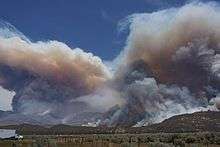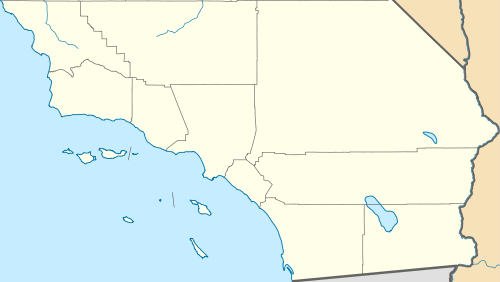Mountain Fire
| Mountain Fire | |
|---|---|
 | |
| Location | Mountain Center, Riverside County, California |
| Coordinates | 33°42′18″N 116°43′34″W / 33.705°N 116.726°W |
| Statistics[1] | |
| Cost | $25.8 million (2013 USD) |
| Date(s) | July 15, 2013 – July 30, 2013 |
| Burned area | 27,531 acres (111 km2) |
| Buildings destroyed | 23 |
| Map | |
 Location of fire in Southern California | |
The Mountain Fire was a wildfire in July, 2013 in Riverside County, California, about 100 miles east of Los Angeles. It burned primarily in the San Jacinto Mountains in the San Bernardino National Forest. It started on July 15, 2013 at 1:43 PM near the junction of Highway 243 and Highway 74. It burned for 16 days on steep slopes of timber and chaparral above Palm Springs. Heavy rainfall, up to 1.5 inches (3.8 cm), on July 21 helped bring the blaze under control.[2] It was fully contained on July 30, 2013.[3]
CalFire investigators said the fire was caused by a failure of "some type of electrical equipment" on private property and was not related to utility company equipment.[4] At the fire's peak there were 3,500 firefighters on the lines as well as 20 helicopters, 12 airplanes and 260 engines.[5] The cost of fighting the fire was estimated at $25.8 million.[3]
For a time the fire threatened the town of Idyllwild and other small towns. The Palm Springs Aerial Tramway and Mount San Jacinto State Park were closed due to unhealhful air quality,[6] and many neighboring areas were warned of possible unhealthful air conditions. The fire reached to within 2 miles of Palm Springs, which was draped by a blanket of ash and smoke.
Nearly 6,000 residents of the Idyllwild and Fern Valley areas were ordered to evacuate; those communities were not damaged by the fire and the evacuation orders were lifted July 21.[2] Evacuation centers were set up at Hemet High School in Hemet, Hamilton High School in Anza and Beaumont High School in Cherry Valley.[6]
Evaluating the effect of the fire, scientists say it may prove to be healthy for the Mount San Jacinto environment, because in many areas it burned away the understory (leaf litter, brush and downed timber) while leaving the taller trees intact. Rich Minnich, a fire scientist from the University of California, Riverside, said this was a poster child for how Southern California wildfires should burn. "We got an old-growth forest that burned slowly in good weather," he said. "We got a fantastic house cleaning. Someone finally vacuumed the rugs."[7] Ken Kietzer, a scientist with the California state parks, echoed the assessment, saying the fire appears to have worked out well for Mount San Jacinto State Park. "When the fire got into the park, it was for the most part not a crown fire. It was a creeping ground fire. That is going to be very favorable to reducing the buildup of ground fuels and thinning out some of the smaller, shade tolerant understory, which will probably in the long run be a benefit for the park."[7]
A team of researchers from the San Diego Natural History Museum had been in the area studying the flora and fauna of Mount San Jacinto for comparison with a similar study done 100 years earlier by zoologist Joseph Grinnell; they were forced by the fire to evacuate their research camp. They are finding that the forest is much more dense than it was 100 years ago, partly due to decades of fire suppression. The increased density has altered the animal population as well as making the area more susceptible to large, damaging fires.[7]
References
- ↑ "Mountain Fire". InciWeb. Retrieved 1 September 2016.
- 1 2 "Residents return after rain helps crews contain California's Mountain Fire blaze". NBC News. July 22, 2013. Retrieved 22 July 2013.
- 1 2 Cocca, Christine (July 31, 2013). "Mountain Fire Fully Contained After Raging for 16 Days". NBC 4 Southern California. Retrieved 31 July 2013.
- ↑ Schaefer, Samantha (July 26, 2013). "27,500-acre Mountain fire blamed on electrical equipment failure". Los Angeles Times. Retrieved 29 July 2013.
- ↑ "Mountain Fire 49% Contained, Evacuation Orders Remain". KTLA. July 21, 2013. Retrieved 21 July 2013.
- 1 2 Finnegan, Michael (July 20, 2013). "Storms threaten to spread Mountain fire; blaze is 25% contained". Los Angeles Times. Retrieved 20 July 2013.
- 1 2 3 Brennan, Deborah Sullivan (July 29, 2013). "The Big Burn: Scientists say Mountain fire ecologically necessary in area with a century of overgrowth". San Diego Union Tribune.